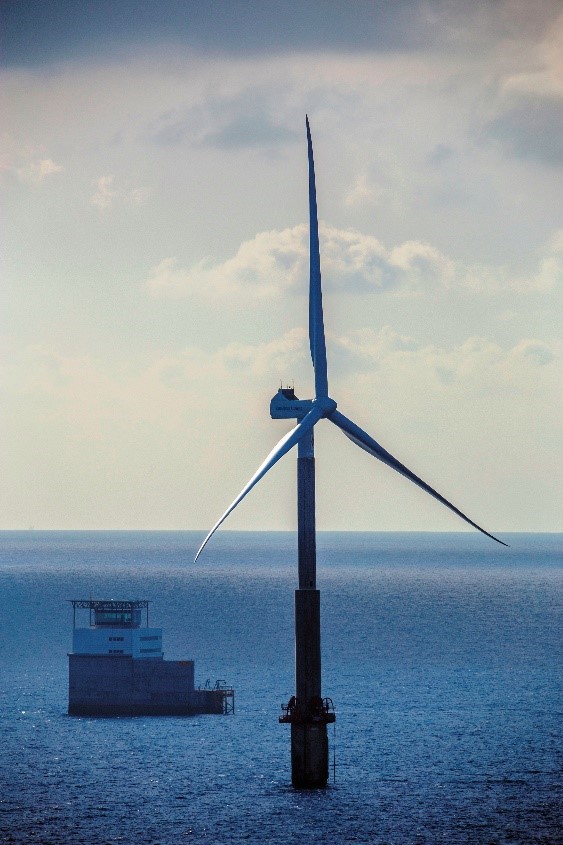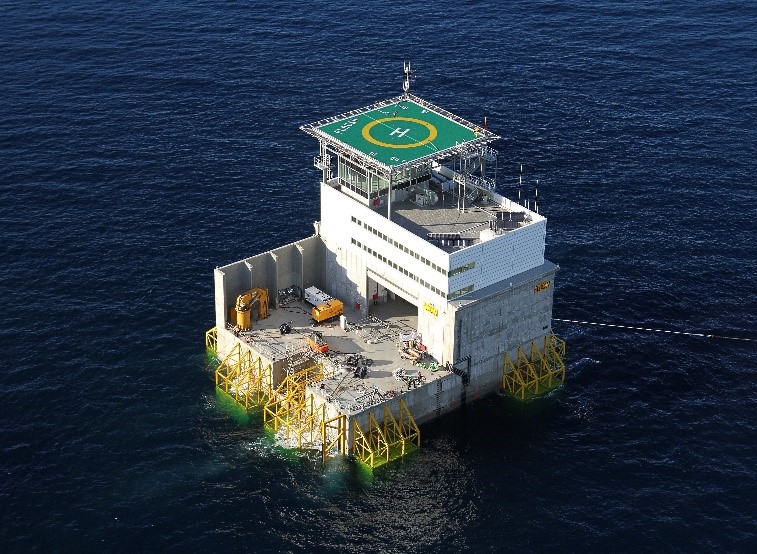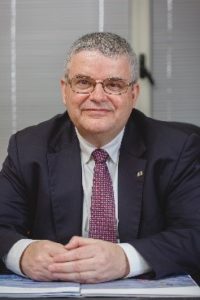An interview with José Joaquín Hernández Brito, director of the Oceanic Platform of the Canary Islands
Oceans have proven to be a fundamental resource in the development of emerging and innovative industries such as energy and biotechnology, which can act as drivers of a sustainable and profitable economy. The Oceanic Platform of the Canary Islands was created in 2007 to build, equip, and operate a set of infrastructures for science and technology research to drive the responsible and sustainable use of marine resources. Its director, José Joaquín Hernández Brito, discussed the huge potential of the so-called “blue economy” with us.
1. Let’s talk about the work your institution does and its goals.
PLOCAN’s basic objective is to accelerate excellent scientific development and the development of technologies to be applied to responsible and sustainable use of the ocean. We are committed to applying knowledge and creating social and economic value by fostering innovative systems that respond to the massive challenges we face, such as the ecological transition, food security, and the preservation and health of the oceans. From our platform, we drive the know-how and technologies required by the blue economy to tap into its potential, contributing to economic diversification and the development of new industries in line with the United Nations SDGs and the Decade of Ocean Science.
The institution aims to act as a catalyst for the concentration of talent and skills around great scientific and technological challenges like extracting renewable energy at costs competitive enough to replace fossil fuels under market conditions. Marine renewable energy will be a fundamental part of the energy transition and decarbonization.
In addition to energy, PLOCAN is committed to offshore sustainable food production, so it combines aquaculture and power generation. It promotes more efficient use of marine space, combining compatible activities, leveraging synergies, and improving environmental observation using reliable data and models that allow for knowledge-based management. It also accelerates technology being transferred among disciplines and sectors that can add value to the exploration and management of the ocean, fostering public-private collaboration and the adaptation of regulations to align them with new technologies and business opportunities.
2. PLOCAN is participating in the rejuvenation of the sea and oceans as a fundamental economic engine. Which sectors are most active in the “blue economy”?
The blue economy involves the leveraging of marine resources, including renewable energy, the production of food and compounds with pharmaceutical applications, maritime transport, recreation, and generally any activity done on the cost or the ocean. Its potential is huge and largely untapped. Nevertheless, responsible management of the marine environment is now quite pressing for a number of critical reasons. On the one hand, the ocean is the environment that controls the conditions to support life as we know it today on this planet. Human impact on the planet is exceeding the environment’s natural ability to maintain its current balance. We need to understand its current state and where it is headed and mitigate any potentially harmful changes. To do that, there has to be a coordinated international effort, and new technologies and sustainable business models must be developed.
Moreover, we’re seeing huge opportunities to leverage renewable resources, replacing unsustainable practices that are harmful to the health of the oceans with environmental management that maintains the power and services offered by the ecosystem. We have to understand and value the natural capital of the seas and oceans and manage it with intelligence, preserving their power for the generations to come.
3. What infrastructures do you have and what is their purpose?
PLOCAN has a test site, an offshore rig, a fleet of observation platforms, an onshore base, and data processing capabilities.
We work on the coast and in the open ocean. Very little is still known about the ocean, so the challenge posed by the Decade of Ocean Science is to deepen that understanding to be able to sustainably manage the ocean as long as possible, before climate change affects the balance in an irrevocable way and before the disappearance of species and ecosystems essential to the biodiversity or health of the oceans.
The next few years will be truly thrilling given the amount of data the observation technology will produce. We estimate that more marine observation data was collected in 2018 alone than in the whole of the 20th century. This was a result of the technological development of sensors, the availability of drones, platform markers, and satellites, among others. All of this leads to new and increasingly sophisticated and precise ways of processing data, the application of artificial intelligence, and the availability of virtual models that can provide simulations and reports which are extremely useful for responsible marine management.

PLOCAN developed the first connected offshore wind turbine running on offshore wind energy and using a telescopic system made of pre-cast concrete.
4. You have a sizable facility: a 23 km2 test site at a depth of 600 meters. What activities are carried out there and how are they coordinated?
The test site serves to experiment on all kinds of technologies and scientific concepts in conditions representative of the marine environment, so the researchers and technology developers can test their devices and learn based on their interactions with the real environment. The area has a number of points for testing wind turbines anchored to the seabed as well as floating turbines. There are also areas dedicated to aquaculture and the installation of devices to harness wave energy. The test site also has multipurpose spaces.
The planning was done to facilitate the simultaneous integration of the different activities, offering users the ideal conditions for installing their equipment under a wide variety of conditions. Users are required to follow a number of common protocols to guarantee the safety and integrity of individual actions and prevent undesired effects or influences. There are further protocols that certify the safety of operations, control of activities, and compliance with technical and regulatory requirements to integrate power, data management, and food production. One of the main elements we pay attention to is the integration of emerging and traditional activities. This is how fishing activity was able to be introduced in areas with wind farms.
5. What are the most important projects currently being carried out?
PLOCAN is currently working on over 40 highly significant international projects, but I’d like to highlight the ones that led to the development of the first connected offshore wind turbine running on offshore wind power. I’m referring to the ELICAN project led by the Spanish company ESTEYCO, which features a telescopic system made of pre-cast concrete
Other projects along this line, such as FLOTANT and MUSICA, promote technologies for developing deep water floating wind farms, a field of special interest in the Canary Islands with participation from many Spanish and European companies. I’d also like to highlight a couple of other projects led by Spanish companies in this area, such as PIVOTBUOY, which has an incredibly novel concept for cost reduction. It will be tested at the end of 2020. Along the same testing line, in 2019, ENEROCEAN created a floating wind turbine prototype with two turbines mounted on the same flotation system. Another notable plan in this area is DESAL+, where emerging desalination technologies are researched for use in renewable energy and the circular economy.
In the observation area, I would underscore the projects that aim to reduce observation costs by using new sensors, as is the case of JONAS, JERICO, and NEXOS. These projects have allowed for the development of new systems to detect marine pollution including plastics as well as other less apparent types of pollution like noise. We are working with several international consortiums along this line, including the GROOMII project, to improve underwater drones by integrating new sensors and optimizing their energy requirements and auto pilot systems.
PLOCAN is also participating in strategic projects to coordinate operations in the Atlantic, such as the AORA and AANChOR projects to promote the implementation of research and innovation initiatives in the Northern Atlantic (Galway Statement) and the Southern Atlantic (Belém Statement). These statements were signed by the EU and coastal countries for research and innovation cooperation in the Atlantic basin from Antarctica to the Arctic.
6. Could you tell us how offshore infrastructure at this scale is maintained?
Maintenance on this kind of infrastructure is quite an undertaking as the sea is in constant motion and can put extraordinary stress on the installations under certain circumstances. The materials are also subject to erosion, corrosion, and the growth of biological organisms that are especially serious and costly. That’s why continuous maintenance is both critical and expensive. Any operation that is quite simple on land – such as lifting loads, transporting equipment, materials, and people – becomes much more complicated in the marine environment.
I’d also like to mention our safety protocols, which are pivotal to people’s health and safety. These protocols are especially rigorous to prevent accidents and any situations that may pose a risk to people.
7. You also have a large fleet of submarines and underwater tools that provide technical and logistical support to your operations. What can they do? What operational risks do they face?
The vehicles we have, especially our underwater gliders, are sufficiently autonomous to remain submerged for months and can travel distances of several thousand kilometers, depending on the number of sensors and how frequently measurements are taken. These vehicles have evolved spectacularly over the last few years and they now boast reduced energy consumption and increased autonomy. They continue to experience issues of organisms becoming attached to them on missions lasting many months, which hinders their movement.
The operational risks they face derive from the characteristics of the environment itself, where sometimes organisms become attached, while interactions with other vessels and animals can lead to the loss or breakdown of equipment. They also require constant surveillance while steering because, although some missions can be carried out on autopilot, decisions often need to be made and the experience of an operator in these moments is critical.

The offshore rig includes workshops, labs, smart energy management systems, observation systems, and a skills base for logistics on the testing site.
8. You are closely connected to the energy industry and even have a smart marine network that provides support for industry experiments and testing. How does it work and what is it comprised of?
The smart energy management network is essential for the integration of different renewable power generation devices without being affected by any events that may occur with other pieces of equipment. This way, the shutdown or disconnection of one piece of equipment does not cause problems in others. The system also regulates consumption intelligently, charging batteries or systems that can consume energy based on need or operations taking place on the rig.
These smart networks will be increasingly commonplace in managing production, consumption, and transmission to the transport or distribution network. Implementation is currently being finalized, and, when it is completed, it will also serve to save on electricity consumption and for research on the integration of energy vectors like water, hydrogen, and ammonia.
9. Let’s talk about the industry. From your point of view, how has oceanic energy developed?
Oceanic energy has developed at a different pace. Like onshore solar power, in terms of technology and cost, offshore wind power has evolved at a fast pace, even faster than predicted decades ago. All of this has been driven by the entry of investors, recycling know-how and logistics from the oil and gas industry, as well as institutional drive and funding for innovation and technology provided both by governments and private companies. The size and output of the turbines has also evolved, and capacities above 10 MW are starting to become commonplace. This is something that could only be speculated about a decade ago. In the coming decade, the challenge will be for deep water floating wind farms, which are looking to cut costs to compete price-wise with shallow water power generation.
Despite all the investments made and expectations created at the end of the 20th century, it has not progressed at the same pace in terms of cutting costs and developing structures resistant to sea activity for the amount of time necessary for it to pay off. Large storms and extreme weather events seriously impact these devices and raise costs. Nevertheless, over the next few years, the expectation is for waves to also contribute to the energy mix in isolated or remote areas to power structures and devices in the marine environment such as aquaculture, unmanned vehicles, and situations of emergency, among others.
10. Could you specifically discuss the development of these energy sources in Latin America and the areas with the most potential in that region?
Latin America has an incredible amount of potential. Countries like Brazil, Argentina, Mexico, and Chile have areas with huge wind power potential. For instance, the offshore power capacity in Brazil just in shallow waters (up to 50 meters) is over 700 GW, with average wind speeds above 7 m/s at 100 meters high. When floating wind power technology is used, which clearly allows for installations at much deeper depths, this amount could grow exponentially (7.2 TW in the exclusive zone). This theoretical potential will evolve as the technology develops in the coming years.
Argentina is another country with a great deal of potential for fixed installations in shallow waters (above 550 GW) and for floating wind farms (above 1.2 TW).
11. What challenges is the industry facing at the international level? In your opinion, what are the next milestones to come in the evolution of offshore energy?
The industry is facing a fundamental technological challenge: lowering the cost of floating wind power to prices that are competitive — not with oil — but compared to other renewable energy sources and onshore wind power. The next few years will see an intense international race to technological convergence, more efficient designs with logistic advantages, multipurpose platforms, new accumulation systems, and energy vectors to get the energy onshore and use it offshore. The Canary Islands have a great opportunity to participate in this process, especially as a demonstrator and testing area for new power generation technology and business models in isolated systems. Local availability of large amounts of low-cost energy will cause current paradigms to shift, decoupling economic growth from carbon dioxide and other pollutant gas emissions.
Looking to the future, there will come a day when our grandchildren will bemusedly ask us why we burned coal and oil to produce energy, the same way we currently think about past eras when we lit our homes with candles and oil lamps.

Article contributor:
José Joaquín Hernández Brito holds a PhD in Chemistry (1986) from the University of La Laguna and has been a professor of marine sciences at University of Las Palmas de Gran Canaria since 1983. From 2009 to 2018, the year he began working for AIR CENTRE, he was the head of ICTS PLOCAN.
He has worked as a marine science researcher, directed five dissertations, led more than 30 national and international projects, written over 60 papers published in scientific journals and presented at international conferences, and worked on scientific multimedia projects.





